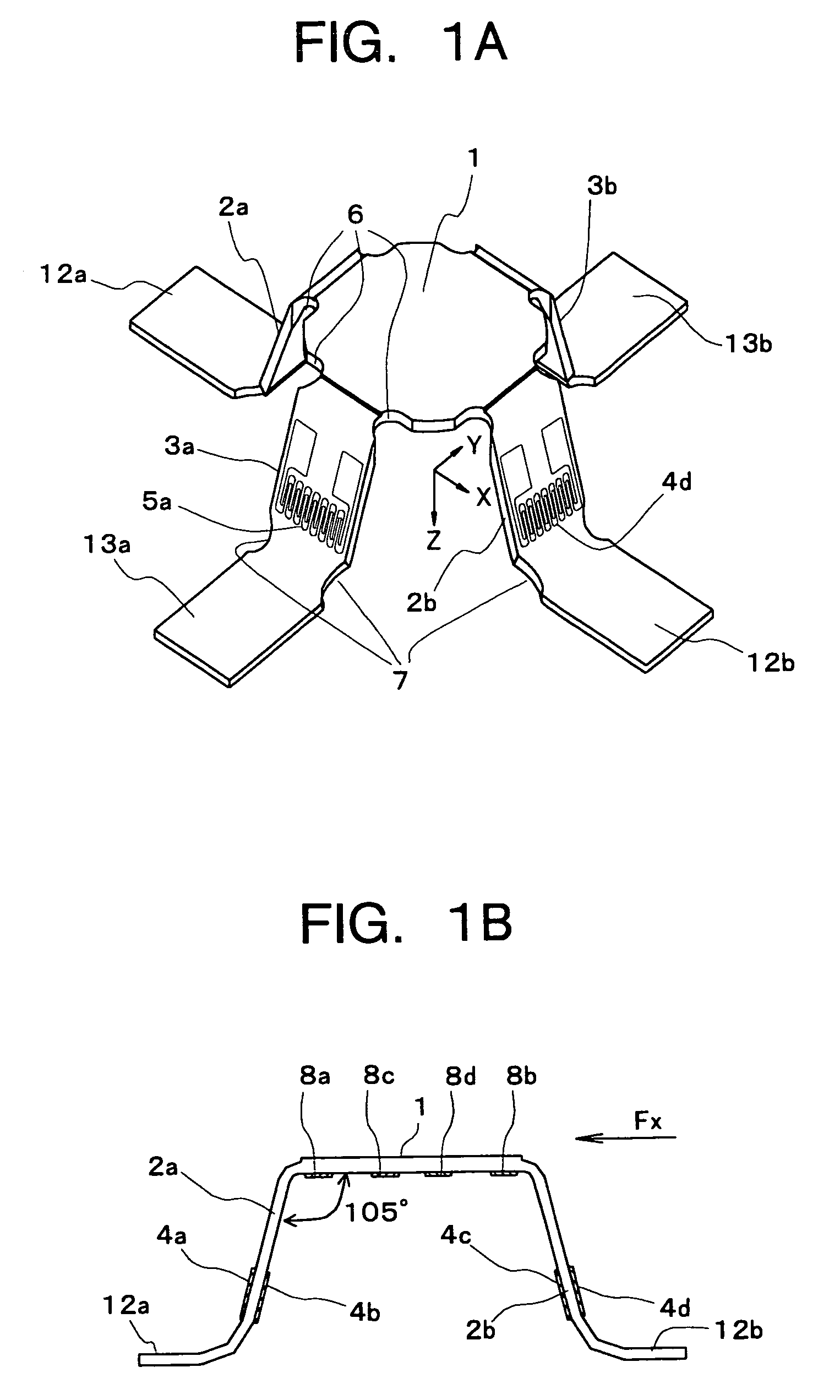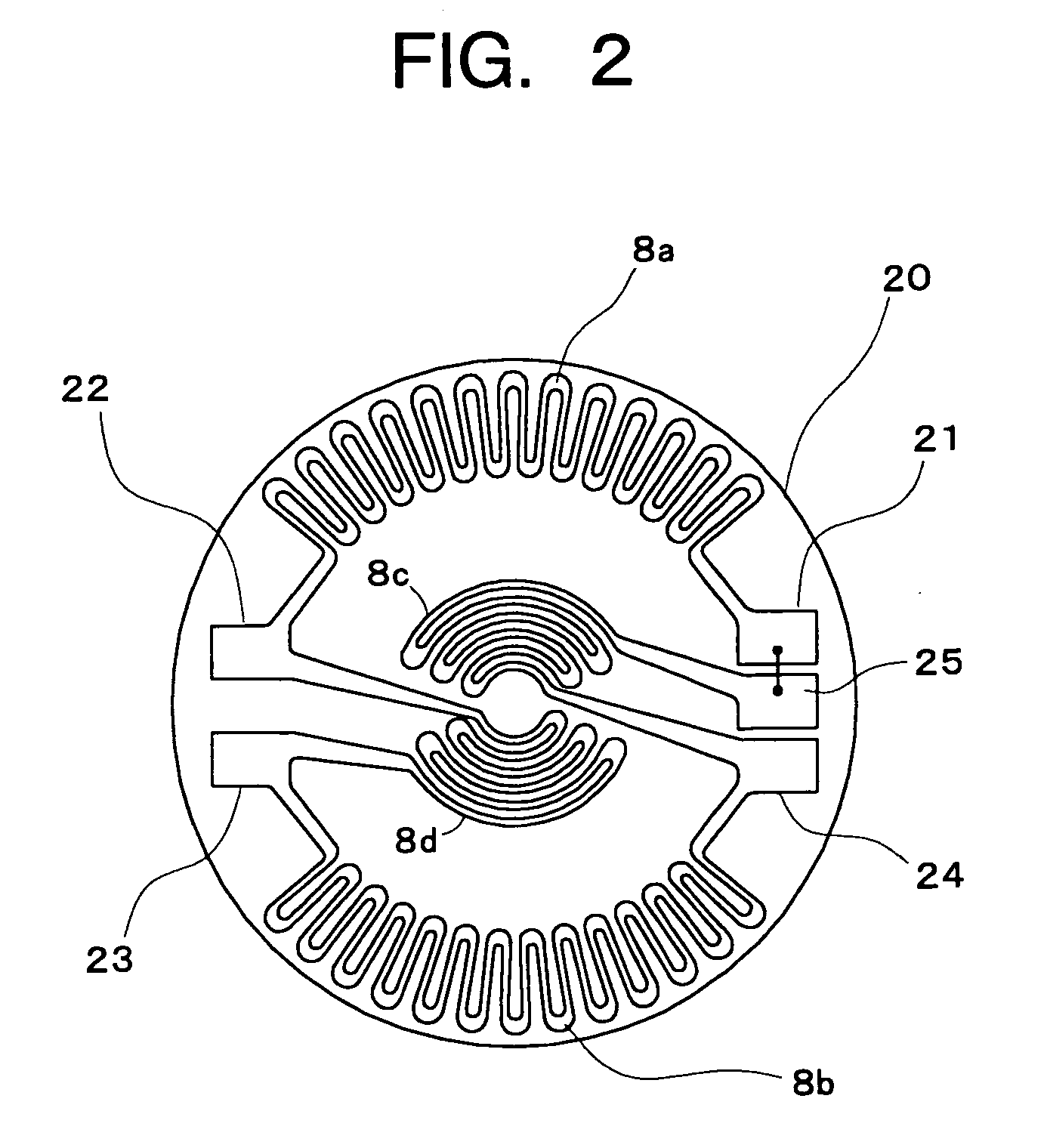Tactile sensor and gripping robot using the same
a technology of tactile sensor and gripping robot, which is applied in the direction of force measurement, instruments, force/torque/work measurement apparatus, etc., can solve the problems of unsuitable small force detection with high accuracy, and the sensor is difficult to attach the sensor to the surface of the skin or the fingertip, so as to reduce mutual interference, improve detection accuracy, and be easy to bend
- Summary
- Abstract
- Description
- Claims
- Application Information
AI Technical Summary
Benefits of technology
Problems solved by technology
Method used
Image
Examples
first example
[First Example]
[0059]Hereinbelow, examples will be described. As a first example, a tactile sensor is formed by punching a metal plate having a thickness of 0.1 mm into a cross shape using a press and by bending it so as to leave a center planer portion as shown in FIG. 1. The height of the tactile sensor is set to 1.6 mm.
[0060]The input voltage into a bridge circuit by strain gauges 4a, 4b, 4c, 4d (5a, . . . ) is set to 5V. The nominal resistance values of the strain gauges 4a, 4b, 4c, 4d (5a, . . . ) are 350 Ω, respectively. After fixing undersurfaces of four foot sections 12a, 12b. 13a, 13b
of the tactile sensor to an attachment surface, a force Fx=250 g is applied in the X direction. The evaluation items are three: output voltage of a bridge circuit, interference between a detection of Fx and a detection of Fy, and nonlinearity in Fx detection.
[0061]As a result obtained from the above, the output voltage of the bridge circuit was 1.7 mV to 1.8 mV, the interference between the de...
second example
[Second Example]
[0062]In a second example, strain gauges are attached only to single sides of strain generating sections 2a, 2b, 3a, 3b (only outside strain gauge 4a, 4d, 5a, . . . are attached), and the same structure as of the first example is adopted for the other structure. This structure is shown in FIG. 5A and FIG. 5B. FIG. 5A and FIG. 5B are views schematically showing the structure of the tactile sensor of another embodiment according to the present invention and the same reference numerals will be used to designate the corresponding components as those already described in the above.
[0063]A bridge circuit composed of strain gauges 4a, 4b is configured by replacing the strain gauges 4b, 4c in the bridge circuit shown in FIG. 4B with external fixed resistors. At the time, as in the case of the first example, a force Fx=250 g is applied in the X direction. As a result obtained from the above, the output voltage of the bridge circuit was 0.85 mV to 0.9 mV, the interference bet...
third example
[Third Example]
[0064]In a third example, no recessed portion is provided in the vicinity of boundaries between a strain generating section 1 and strain generating sections 2a, 2b, 3a, 3b, which are four legs, and in the vicinity of boundaries between the strain generating sections 2a, 2b, 3a, 3b and foot sections 12a, 12b, 13a, 13b. The other structure is the same as of the first example. This structure is shown in FIG. 6A and FIG. 6B. FIG. 6A and FIG. 6B are views schematically showing the structure of the tactile sensor of still another embodiment according to the present invention and the same reference numerals will be used to designate the corresponding components as those already described in the above.
[0065]As in the case of the first example, a force Fx=250 g is applied. As a result obtained from the above, the output voltage of the bridge circuit was 0.5 mV to 0.55 mV, the interference between the detection of Fx and the detection of Fy was 30% or below, and the nonlineari...
PUM
| Property | Measurement | Unit |
|---|---|---|
| angle | aaaaa | aaaaa |
| angle | aaaaa | aaaaa |
| angle | aaaaa | aaaaa |
Abstract
Description
Claims
Application Information
 Login to View More
Login to View More - R&D
- Intellectual Property
- Life Sciences
- Materials
- Tech Scout
- Unparalleled Data Quality
- Higher Quality Content
- 60% Fewer Hallucinations
Browse by: Latest US Patents, China's latest patents, Technical Efficacy Thesaurus, Application Domain, Technology Topic, Popular Technical Reports.
© 2025 PatSnap. All rights reserved.Legal|Privacy policy|Modern Slavery Act Transparency Statement|Sitemap|About US| Contact US: help@patsnap.com



